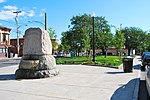Albany Law School
1851 establishments in New York (state)Albany Law SchoolLaw schools in New York (state)

Albany Law School is a private law school in Albany, New York. It was founded in 1851 and is the oldest independent law school in the nation. It is accredited by the American Bar Association and has an affiliation agreement with University at Albany that includes shared programs. The school is located near New York's highest court, federal courts, the executive branch, and the state legislature.
Excerpt from the Wikipedia article Albany Law School (License: CC BY-SA 3.0, Authors, Images).Albany Law School
New Scotland Avenue, City of Albany
Geographical coordinates (GPS) Address Nearby Places Show on map
Geographical coordinates (GPS)
| Latitude | Longitude |
|---|---|
| N 42.652363888889 ° | E -73.777333333333 ° |
Address
New Scotland Avenue
12208 City of Albany
New York, United States
Open on Google Maps








